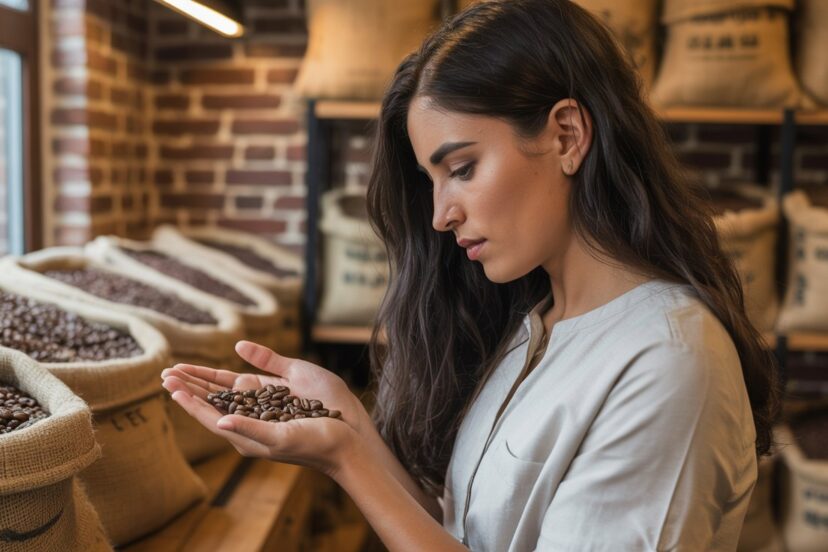Can You Eat Coffee Beans Safely?
*We may earn a commission for purchases made using our links. Please see our disclosure to learn more.
Coffee beans aren’t just for brewing, they’re a nutritious, crunchy snack that’s been enjoyed worldwide for centuries. While most people only think of coffee beans as the foundation for their daily cup, these aromatic seeds offer a completely different experience when consumed whole.
The answer is definitively yes: coffee beans are safe to eat and provide unique benefits that go far beyond traditional coffee consumption. From concentrated caffeine delivery to intense flavor experiences, eating coffee beans opens up an entirely new dimension of coffee appreciation that many enthusiasts have yet to discover.
Key Takeaways
- Coffee beans are completely safe and edible when consumed in moderation
- Eating coffee beans provides concentrated caffeine—much more than regular coffee
- Dark roasted beans are easier to digest and have a more pleasant flavor profile
- Raw green coffee beans are edible but significantly more bitter and harder to chew
- Moderate consumption offers unique health benefits, but excessive intake can cause side effects
- Chocolate-covered coffee beans represent the most popular way to enjoy edible coffee beans
“Coffee beans are not just the foundation of our beloved beverage—they’re a nutritious, energy-packed snack that has been enjoyed in various cultures for centuries.”
– International Coffee Research Institute
The Journey from Curiosity to Culinary Discovery
Understanding What You’re Actually Eating
When you bite into a coffee bean, you’re experiencing the seed of the coffee cherry in its most concentrated form. Unlike the diluted version you drink, eating coffee beans delivers an intense burst of flavor, caffeine, and nutrients that can be both surprising and delightful.
The transformation from coffee cherry to the beans in your pantry involves multiple stages of processing, roasting, and preparation. Each step influences not only the safety of consuming the beans but also their taste, texture, and nutritional profile.
Types of Coffee Beans You Can Eat
Roasted Coffee Beans: The Popular Choice
Roasted coffee beans represent the most common and enjoyable way to eat coffee beans. The roasting process transforms the hard, green seeds into the familiar brown, aromatic beans we associate with coffee. This process creates several advantages for consumption:
Light to Medium Roasts offer bright, acidic flavors with floral and fruity notes. These beans retain more of their original caffeine content and can provide a zingy, energetic experience when eaten whole.
Dark Roasts provide a smoother eating experience with rich, chocolatey, and sometimes smoky flavors. The extended roasting process breaks down some of the more challenging compounds, making them easier on your digestive system.
Raw Green Coffee Beans: The Adventurous Option
Green coffee beans—the unroasted seeds—are technically edible but present a more challenging eating experience. They’re significantly harder, more bitter, and require substantial chewing. However, they contain higher levels of chlorogenic acid, a powerful antioxidant that diminishes during roasting.
Many health enthusiasts choose green coffee beans for their potential weight management and antioxidant benefits, though the taste requires some getting used to.
Chocolate-Covered Coffee Beans: The Gateway Experience
For those hesitant about diving straight into plain coffee beans, chocolate-covered varieties offer an excellent introduction. The sweet coating balances the bitter coffee flavor while providing a familiar candy-like experience that makes the transition to eating coffee beans much more pleasant.
The Sensory Experience of Eating Coffee Beans
Texture and Mouthfeel
Biting into a coffee bean creates a unique sensory experience. The initial crunch gives way to a somewhat grainy texture as you chew. Roasted beans have a satisfying snap, while the interior reveals a more powdery consistency that gradually releases oils and flavors across your palate.
Flavor Profiles and Intensity
The flavor intensity of eaten coffee beans far exceeds what you experience in brewed coffee. Single-origin beans showcase their terroir more dramatically when eaten whole, allowing you to taste the subtle differences between regions, processing methods, and roasting techniques.
Ethiopian beans might burst with blueberry and wine-like notes, while Colombian beans offer nutty, caramel undertones. This concentrated flavor experience helps develop a deeper appreciation for coffee’s complexity.
Health Benefits and Nutritional Aspects
Concentrated Caffeine Content
One coffee bean contains approximately 6-12 milligrams of caffeine, meaning that eating just 10-15 beans equals roughly one cup of coffee. This concentrated delivery system provides sustained energy without the water volume of traditional coffee consumption.
Antioxidant Powerhouse
Coffee beans are packed with antioxidants, including chlorogenic acids, quinides, and other phenolic compounds. These substances help combat free radicals in your body and may contribute to reduced inflammation and improved cellular health.
Fiber and Mineral Content
Whole coffee beans provide dietary fiber, potassium, magnesium, and niacin. While you won’t get massive quantities from casual snacking, regular consumption can contribute to your daily nutritional intake.
Common Challenges and How to Overcome Them
Managing Caffeine Sensitivity
The concentrated caffeine in coffee beans can overwhelm sensitive individuals. Start with just 2-3 beans and gradually increase your tolerance. Pay attention to how your body responds and adjust accordingly.
Digestive Considerations
Some people experience stomach upset when eating coffee beans, especially on an empty stomach. The high fiber content and natural acids can cause discomfort. Combat this by eating beans with food or limiting your initial consumption.
Developing Your Palate
The intense, sometimes bitter flavor of plain coffee beans can be off-putting initially. Begin with chocolate-covered varieties or mix beans with nuts and dried fruits to create a more balanced flavor profile.
Finding Quality Beans for Eating
Not all coffee beans are created equal for eating purposes. Look for high-quality, organic beans from reputable roasters. Avoid overly oily dark roasts, which can leave an unpleasant coating in your mouth.
Creating Your Coffee Bean Eating Routine
Starting Your Journey
Begin with small quantities—perhaps 3-5 beans per day. This allows your system to adjust while letting you explore different flavor profiles without overwhelming your palate or digestive system.
Timing and Frequency
Many coffee bean enthusiasts find that eating beans in the afternoon provides an excellent energy boost without interfering with sleep patterns. The sustained release of caffeine offers longer-lasting energy compared to drinking coffee.
Pairing and Combinations
Experiment with pairing coffee beans with complementary flavors. Dark chocolate, nuts, dried fruits, or even cheese can create interesting flavor combinations that enhance the overall eating experience.
The Broader Impact on Your Coffee Appreciation
Developing Coffee Expertise
Eating coffee beans transforms your relationship with coffee. You’ll begin recognizing subtle flavor differences in your brewed coffee, developing a more sophisticated palate that enhances your overall coffee enjoyment.
Understanding Processing and Origin
When you eat beans from different regions and processing methods, you gain intimate knowledge of how these factors influence flavor. This understanding makes you a more informed coffee consumer and enthusiast.
Connecting with Coffee Culture
Eating coffee beans connects you to centuries of coffee culture. In many coffee-growing regions, consuming coffee cherries and beans has been traditional practice long before modern brewing methods developed.
Safety Considerations and Moderation
Recommended Daily Limits
Health experts suggest limiting coffee bean consumption to the equivalent of 2-3 cups of coffee per day, which translates to roughly 30-45 individual beans. This ensures you gain benefits without risking caffeine-related side effects.
Recognizing Overconsumption Signs
Watch for symptoms like jitters, anxiety, rapid heartbeat, or sleep disruption. These signs indicate you may be consuming too many beans and should reduce your intake.
Special Considerations for Certain Groups
Pregnant women, individuals with heart conditions, and those taking certain medications should consult healthcare providers before regularly eating coffee beans due to the concentrated caffeine content.
Different Approaches for Various Goals
For Energy and Focus
If your goal is sustained energy, eat 5-8 medium roast beans in the early afternoon. The gradual caffeine release provides steady alertness without the crash associated with some energy drinks.
For Antioxidant Benefits
Green coffee beans offer maximum antioxidant content, though they require more effort to consume. Alternatively, light roast beans retain more beneficial compounds than darker roasts.
For Flavor Exploration
Treat coffee bean eating as a tasting journey. Try single-origin beans from different regions, comparing their distinct characteristics and developing your flavor preferences.
For Weight Management
Some studies suggest that compounds in coffee beans may support metabolism. Combined with their appetite-suppressing effects, moderate consumption might support weight management goals.

Building a Community Around Coffee Bean Appreciation
Sharing the Experience
Coffee bean eating creates opportunities for sharing unique experiences with fellow coffee enthusiasts. Hosting tasting sessions or sharing discoveries on social media connects you with like-minded individuals.
Learning from Others
Engage with online communities, coffee shops, and roasters who can provide insights into the best beans for eating, preparation techniques, and flavor profiles worth exploring.
Cultural Perspectives
Research how different cultures incorporate coffee bean consumption into their traditions. This broader perspective enriches your own experience and appreciation.
Celebrating Your Coffee Bean Journey
Acknowledging Small Discoveries
Each new bean variety you try represents a small victory in expanding your palate and coffee knowledge. Celebrate these discoveries by keeping a journal of your experiences and preferences.
Sharing Your Transformation
Document your journey from curious coffee drinker to confident coffee bean consumer. Your story might inspire others to explore this unique aspect of coffee culture.
Continuing Education
Stay curious about new roasting techniques, origin stories, and processing methods. The world of coffee beans offers endless opportunities for learning and discovery.
Conclusion: Embracing the Crunchy Side of Coffee Culture
Eating coffee beans transforms a simple curiosity into a rich, multifaceted experience that deepens your connection to coffee culture. From the initial crunch to the lingering flavor, consuming whole coffee beans offers unique benefits that extend far beyond traditional brewing methods.
Whether you’re seeking concentrated energy, exploring complex flavors, or simply satisfying curiosity, coffee beans provide a safe, nutritious, and enjoyable eating experience when consumed mindfully. The journey from questioning “can you eat coffee beans?” to confidently incorporating them into your routine represents more than dietary experimentation—it’s an exploration of tradition, flavor, and the remarkable versatility of coffee.
Remember that like any food, moderation is key. Start small, listen to your body, and allow your palate to develop gradually. The world of edible coffee beans offers countless varieties, flavors, and experiences waiting to be discovered.
Your coffee bean eating journey doesn’t end with this article—it begins here. Each bean you try, each flavor you discover, and each moment of sustained energy you experience adds another chapter to your personal coffee story. Embrace the adventure, celebrate the discoveries, and enjoy every crunchy, caffeinated bite.
Frequently Asked Questions
1. How many coffee beans can you safely eat per day?
You can safely consume 30-45 coffee beans per day, which equals approximately 2-3 cups of coffee in caffeine content. Start with fewer beans initially to assess your tolerance, and always listen to your body’s response.
2. Do roasted coffee beans taste better than raw green beans?
Yes, roasted coffee beans are generally more palatable than raw green beans. Roasting develops complex flavors, reduces bitterness, and creates a more pleasant texture. Green beans are extremely hard, very bitter, and require significant chewing effort.
3. Can eating coffee beans help with weight loss?
Coffee beans may support weight management through their caffeine content, which can boost metabolism and suppress appetite. However, they’re not a magic solution—effective weight loss requires a balanced diet and regular exercise alongside any coffee bean consumption.
4. Are there any side effects to eating coffee beans?
Potential side effects include jitters, anxiety, rapid heartbeat, stomach upset, and sleep disruption, especially when consuming large quantities. People sensitive to caffeine should start with very small amounts and monitor their body’s response.
5. What’s the best way to eat coffee beans for beginners?
Start with chocolate-covered coffee beans or high-quality dark roast beans. Begin with just 2-3 beans per day, eat them with food to minimize stomach upset, and gradually increase quantity as your tolerance develops. Avoid eating beans late in the day to prevent sleep interference.




